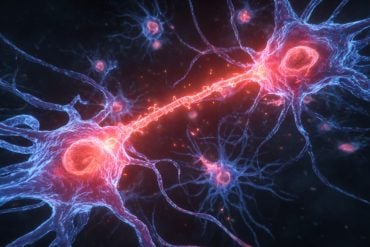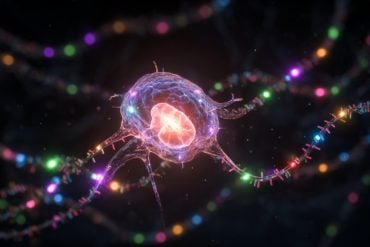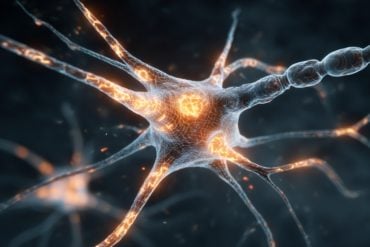Summary: A new study reports on a new method of stem cell transplantation that could help people with Duchenne muscular dystrophy.
Source: IOS Press.
Satellite cells are stem cells found in skeletal muscles. While transplantation of such muscle stem cells can be a potent therapy for degenerative muscle diseases such as Duchenne muscular dystrophy, these cells tend to lose their transplantation efficiency when cultured in vitro. In a study in the current issue of the Journal of Neuromuscular Diseases, researchers treated these stem cells with leukemia inhibitory factor (LIF), which effectively maintained the undifferentiated state of the satellite cells and enhanced their transplantation efficiency.
To have enough cells for transplantation, they must be grown in vitro and prevented from differentiating before transplantation. Several growth factors, cytokines, and chemicals have been used in muscle stem cell cultures, but the optimal culture conditions required to maintain the undifferentiated state, inhibit differentiation, and enhance eventual transplantation efficiency have not yet been established.
LIF is thought to be involved in muscle regeneration. The investigators found that when LIF-treated muscle stem cells were transplanted to skeletal muscle, they formed two to three times more muscle fibers as control cells did.

“To the best of our knowledge, this study provides the first report of the effect of LIF on the transplantation efficiency of primary satellite cells,” explained Shin’ichi Takeda, MD, PhD, of the Department of Molecular Therapy, National Institute of Neuroscience, National Center of Neurology and Psychiatry, Kodaira, Japan. “This research enables us to get one step closer to the optimal culture conditions for muscle stem cells.”
Dr. Takeda added, “However, precise mechanisms of LIF for the enhancement of transplantation efficiency remain unknown. Investigations aimed at determining the downstream targets of LIF would help to clarify the functional importance of LIF in muscle regeneration, and further its potential application in cell transplantation therapy.”
Source: D.Watrin – IOS Press
Image Source: This NeuroscienceNews.com image is credited to IOS Press.
Original Research: Full open access research for “Enhancement of Satellite Cell Transplantation Efficiency by Leukemia Inhibitory Factor” by Ito, N.; Shimizu, N.; Tanaka, H.; and Takeda, S. in Journal of Neuromuscular Diseases. Published online June 6 2016 doi:10.3233/JND-160156
[cbtabs][cbtab title=”MLA”]IOS Press. “New Method to Grow and Transplant Muscle Stem Cells Holds Promise for Treatment of MD.” NeuroscienceNews. NeuroscienceNews, 28 June 2016.
<https://neurosciencenews.com/muscular-dystrophy-neurology-4597/>.[/cbtab][cbtab title=”APA”]IOS Press. (2016, June 28). New Method to Grow and Transplant Muscle Stem Cells Holds Promise for Treatment of MD. NeuroscienceNews. Retrieved June 28, 2016 from https://neurosciencenews.com/muscular-dystrophy-neurology-4597/[/cbtab][cbtab title=”Chicago”]IOS Press. “New Method to Grow and Transplant Muscle Stem Cells Holds Promise for Treatment of MD.” https://neurosciencenews.com/muscular-dystrophy-neurology-4597/ (accessed June 28, 2016).[/cbtab][/cbtabs]
Abstract
Enhancement of Satellite Cell Transplantation Efficiency by Leukemia Inhibitory Factor
Background and Objectives: Cell transplantation is a promising therapy for several muscle diseases, including Duchenne muscular dystrophy. Satellite cells are stem cells in skeletal muscle that provide an important cell source for transplantation therapy. However, culture of satellite cells in vitro causes them to lose their undifferentiated state, associated with reduced transplantation efficiency. It is therefore necessary to develop optimal culture conditions for maintaining the undifferentiated state of satellite cells.
Methods: Primary satellite cells were cultured with or without leukemia inhibitory factor (LIF). The expression of undifferentiation and differentiation markers, and the transplantation efficiency were analyzed.
Results: LIF-treated satellite cells showed increased expression of Pax7, and enhanced transplantation efficiency in a mouse model of Duchenne muscular dystrophy.
Conclusions: Our study showed that the treatment with LIF effectively maintained the undifferentiated state of satellite cells, and enhanced their transplantation efficiency. These results will contribute to the optimization of culture conditions for cell transplantation therapy.
“Enhancement of Satellite Cell Transplantation Efficiency by Leukemia Inhibitory Factor” by Ito, N.; Shimizu, N.; Tanaka, H.; and Takeda, S. in Journal of Neuromuscular Diseases. Published online June 6 2016 doi:10.3233/JND-160156






